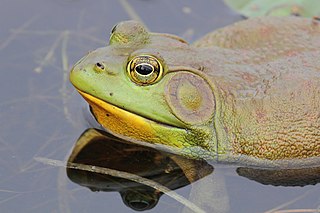 W
WLithobates is a genus of true frogs, of the family Ranidae. The name is derived from litho- (stone) and the Greek bates, meaning one that treads on rock, or rock climber.
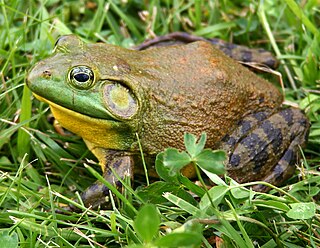 W
WThe American bullfrog, often simply known as the bullfrog in Canada and the United States, is a large true frog native to eastern North America. It typically inhabits large permanent water bodies such as swamps, ponds, and lakes. Bullfrogs can also be found in man made habitats such as pools, koi ponds, canals, ditches and culverts. The bullfrog gets its name from the sound the male makes during the breeding season, which sounds similar to a bull bellowing. The bullfrog is large and is commonly eaten throughout its range, especially in the southern United States where they are plentiful.
 W
WThe Atlantic Coast leopard frog is a species of amphibian that is endemic to the United States. As a member of the genus Rana sensu lato, it is classified as a true frog, with typical smooth skin and a narrow waist. Its range stretches along the northern part of Eastern Seaboard, from Connecticut to North Carolina. The species takes its common name from the speckles on its legs and back reminiscent of a leopard pattern.
 W
WThe bronze frog is a subspecies of Lithobates clamitans found in the southeastern region of North America.
 W
WThe carpenter frog is a species of true frog found on coastal plain of the Atlantic coast of the United States between central New Jersey and northeastern Florida.
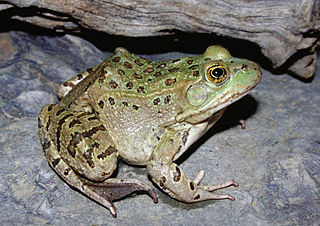 W
WThe Chiricahua leopard frog is a species of frog in the family Ranidae, the true frogs. It is native to Mexico and the United States. Its natural habitats are temperate forests, rivers, intermittent rivers, swamps, freshwater lakes, intermittent freshwater lakes, freshwater marshes, intermittent freshwater marshes, freshwater springs, ponds, and open excavations. It is threatened by habitat loss and chytrid fungus to such an extent that it has been eliminated from 80% of its former habitat. The Phoenix Zoo, Arizona's Department of Game and Fish, and the USFWS are trying to mitigate threats through captive breeding and reintroduction efforts.
 W
WThe green frog is a species of frog native to eastern North America. The two subspecies are the bronze frog and the northern green frog.
 W
WThe crawfish frog is a medium-sized species of frog native to the prairies and grasslands of the central United States. It gets its name because it inhabits the burrows of crayfish for most of the year. They have defined golden or black circles all over their body.
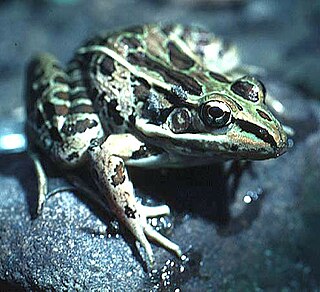 W
WForrer's grass frog or Forrer's leopard frog, Lithobates forreri, is a species of frog in the family Ranidae found in Mexico and Central America through Guatemala, El Salvador, Honduras, and Nicaragua to Costa Rica. It is a widespread and common frog found in lowland and seasonal tropical forests. It can also adapt to man-made habitats such as flooded agricultural lands and other water content systems. Reproduction requires permanent pools and lagoons.
 W
WThe Plains leopard frog It is sometimes referred to as Blair's leopard frog, named after the noted zoologist and University of Texas professor, Dr. W. Frank Blair.
 W
WThe gopher frog is a species of frog in the family Ranidae, endemic to the south-eastern United States. It primarily inhabits the threatened sandhill communities, flatwoods, and scrub in the Atlantic coastal plain, where it is usually found near ponds.
 W
WThe highland frog, also known as the masked mountain frog, is a species of frog in the family Ranidae, known from El Salvador, Guatemala, Honduras, Mexico, and Nicaragua. Its natural habitats are subtropical or tropical moist lowland forests, subtropical or tropical moist montane forests, rivers, and freshwater marshes. It is threatened by habitat loss.
 W
WLithobates brownorum is a species of frog native to southern Veracruz and northeastern Oaxaca east through the Yucatan Peninsula and the uplands of Chiapas in southern Mexico through Guatemala and Honduras to Nicaragua. Its separateness from Lithobates berlandieri has been questioned but molecular data now supports the conclusion that it is a separate species.
 W
WThe river frog is a species of aquatic frog in the family Ranidae. It is endemic to the southeastern United States. Its natural habitats are temperate rivers, swamps, freshwater lakes and freshwater marshes. It is threatened by habitat loss.
 W
WThe Lenca leopard frog is a species of true frog found in the Chortís Highlands of southwestern Honduras at altitudes of 1560 to 2080 m. This frog was long thought to be a hybrid between the two lowland species Lithobates brownorum and Lithobates forreri until 2018 when DNA tests proved the highland leopard frogs to be a distinct species. They are smaller in size but have larger heads than the two lowland species, with males growing between 46.6–64.3 mm while females grow between 43.7–76.3 mm. The Lenca leopard frog is named after the Lenca people, who inhabit the same mountainous region as the frog.
 W
WThe lowland leopard frog is a species of frog in the family Ranidae that is found in Mexico and the United States.
 W
WThe mink frog is a small species of frog native to the United States and Canada. They are so named for their scent, which reportedly smells like a mink. The scent is more akin to that of rotting onions to those unfamiliar with mink. It is also sometimes referred to as the north frog.
 W
WThe Mississippi gopher frog, also known commonly as the dark gopher frog, the dusky gopher frog, and the St. Tammany gopher frog, is a critically endangered species of frog in the family Ranidae. The species is endemic to the southern United States. Its natural habitats are temperate coastal forests and intermittent freshwater marshes. This secretive frog is on average 3 in (8 cm) long, with a dark brown or black dorsal surface covered in warts.
 W
WThe Montezuma leopard frog, Lithobates montezumae, is a species of frog in the family Ranidae endemic to Mexico. Its natural habitats are pine-oak or oak forests above 2,000 m (6,600 ft) asl but it can also survive in moderately altered habitats. It breeds in lakes and big pools. It is potentially threatened by habitat loss and introduced predators. It is also collected for human consumption.
 W
WThe northern green frog is a subspecies of the green frog, Lithobates clamitans. It is native to the northeastern North America and has been introduced to British Columbia. Its mating call sounds like the single note of a plucked banjo. It is also quite common in the pet trade.
 W
WThe northern leopard frog is a species of leopard frog from the true frog family, native to parts of Canada and the United States. It is the state amphibian of Minnesota and Vermont.
 W
WThe Peralta frog, or montane leopard frog, Lithobates taylori, is a species of frog in the family Ranidae found in Costa Rica and Nicaragua.
 W
WThe pickerel frog is a small North American frog, characterized by the appearance of seemingly "hand-drawn" squares on its dorsal surface.
 W
WThe pig frog is a species of aquatic frog found in the Southeastern United States, from South Carolina to Texas. Some sources also refer to it as the lagoon frog or the southern bullfrog.
 W
WThe relict leopard frog is a species of frog in the family Ranidae, endemic to the United States. It is found along the Colorado river in extreme northwestern Arizona, and adjacent Nevada and southwestern Utah, although its present range seems to be restricted to the Lake Mead National Recreation Area. Its natural habitat is freshwater springs and their outlets. It is threatened by habitat loss to agriculture and water development as well as invasive species.
 W
WThe Rio Grande leopard frog is a species of aquatic frog native to the southern United States in Texas and New Mexico, and south through Mexico and Central America. It is also sometimes referred to as the Mexican leopard frog. The epithet berlandieri is in honor of the naturalist Jean Louis Berlandier, who worked for the Mexican government on one of the first biological surveys of Texas.
 W
WThe showy leopard frog is a species of frog in the family Ranidae endemic to Mexico.
 W
WThe southern leopard frog is a species of true frog. It is native to eastern North America from Kansas to New York to Florida. It is also an introduced species in some areas.
 W
WThe Tarahumara frog, Lithobates tarahumarae, is a species of frog in the family Ranidae found in Mexico and—formerly—the United States, where it is now regionally extinct. Its natural habitats are streams and plunge pools in canyons in oak and pine-oak woodland, and foothill thorn scrub and tropical deciduous forest in the Pacific coast tropical area. Permanent water is necessary for reproduction.
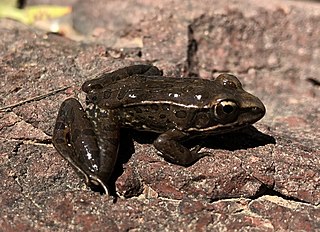 W
WThe transverse volcanic leopard frog is a species of frog in the family Ranidae endemic to the southern edge of the Mexican Plateau, Mexico. Its natural habitats are pine-oak forests and mesquite grasslands near lakes, pools or slow-flowing streams. It is threatened by habitat loss.
 W
WVaillant's frog is a species of frog in the family Ranidae found in Central America. Its natural habitats are subtropical or tropical dry forests, subtropical or tropical moist lowland forests, subtropical or tropical swamps, rivers, swamps, freshwater lakes, intermittent freshwater lakes, freshwater marshes, intermittent freshwater marshes, rural gardens, heavily degraded former forests, water storage areas, ponds, and canals and ditches.
 W
WThe Vegas Valley leopard frog is a species of frog previously declared extinct. Once it occurred in the Las Vegas Valley, as well as Tule Springs, Clark County, southern Nevada, United States of America, at elevations between 370 and 760 m. It was believed to be the only frog endemic to the United States to have become extinct in modern times.
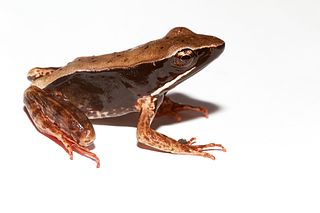 W
WWarszewitsch's frog is a species of frog in the family Ranidae found in Honduras, Nicaragua, Costa Rica, and Panama.
 W
WThe wood frog has a broad distribution over North America, extending from the boreal forest of the north to the southern Appalachians, with several notable disjunct populations including lowland eastern North Carolina. The wood frog has garnered attention by biologists over the last century because of its freeze tolerance, relatively great degree of terrestrialism, interesting habitat associations, and relatively long-range movements.
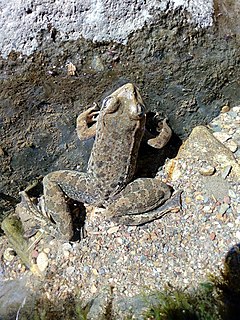 W
WZweifel's frog is an amphibian species endemic to Mexico. It is a member of the true frog family, Ranidae.